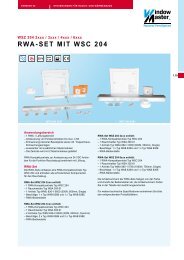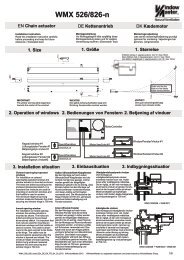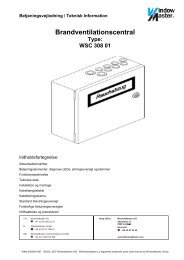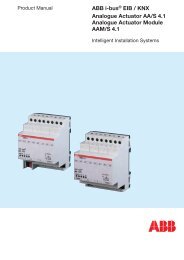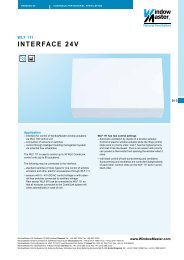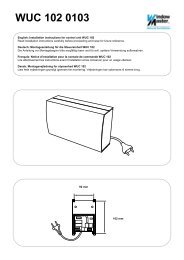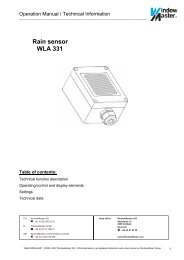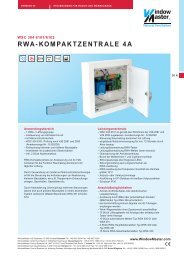WSC 304 6102 Install 0909-GB - WindowMaster
WSC 304 6102 Install 0909-GB - WindowMaster
WSC 304 6102 Install 0909-GB - WindowMaster
- No tags were found...
You also want an ePaper? Increase the reach of your titles
YUMPU automatically turns print PDFs into web optimized ePapers that Google loves.
<strong>WSC</strong> <strong>304</strong> <strong>6102</strong>Smoke control unitOperating manual / Technical informationTable of contents:Safety informationOperating elements and fuse reviewTechnical data<strong>Install</strong>ationCable lengths tableCable planStandard wiring diagramVarious wiring diagramsCommissioningMaintenancewww.<strong>WindowMaster</strong>.com<strong>WindowMaster</strong> A/S Skelstedet 13 2950 Vedbæk Danmark Tel.: +45 4567 0300 Fax: +45 4567 0390<strong>WindowMaster</strong> GmbH Zum Bache 4 32549 Bad Oeynhausen Deutschland Tel.: +49 (0) 5731-7583-0 Fax: +49 (0) 5731-7583-79<strong>WindowMaster</strong> Control Systems Ltd. UNIT 21 Port Tunnel Business Park Dublin 17 Ireland Tel: +353 (0) 1894 1444 Fax: +44 (0) 1536 526321<strong>WindowMaster</strong> AG Industriestrasse 7 4632 Trimbach Schweiz Tel.: +41 (0) 62 289 22 22 Fax: +41 (0) 62 289 22 20<strong>WindowMaster</strong> Control Systems Ltd. Kettering Parkway Wellingborough Road Kettering Northants NN15 6XR United Kingdom Tel.: +44 (0) 1536 510990 Fax: +44 (0) 1536 526321<strong>WSC</strong> <strong>304</strong> <strong>6102</strong> install <strong>0909</strong>-UK ©<strong>WindowMaster</strong> 2009 ®Windowmaster is a registered trademark used under licence by <strong>WindowMaster</strong> Group
Safety information__________________________________________________________________________Attention!Adherence to the following information is mandatory:Only allow correspondingly trained, qualifiedand skilled personnel to carry out installation work.Reliable operation and the avoidance ofdamage and hazards is only guaranteed ifinstallation and settings are carried out carefullyin accordance with these instructions.Check the technical data on the system plate.Hazards to persons ensuing from flaps andwings operated by electric motors.The forces occurring in the automatic mode canbe such that parts of the body could get crushed.When open ed, actuators could protrude into theroom.For this reason, measures have to be takenprior to starting up the actuators which excludethe danger of injury.With wings tilting inwards or outwards, the wingmust be protected from hinging down once theactuator is unhooked (e.g. for window cleaning).For safety reasons we recommend the use ofcatching shears.In the event that wings or flaps are subjected tohigh wind loads, we recommend to connect thecentral control unit to a wind detector which willautomatically close the flaps.The fastening methods are exclusively intendedfor the intended use for which they are designedThe manufacturer does not assume any liabilityfor possible damage resulting from inappropriateuse.230V AC dangerous voltageCan cause death, severe injury or considerabledamage to assets.The connection of the control system is reservedfor qualified personnel.Disconnect all poles of the unit from the supplyvoltage prior to opening, installation orassembling. Adhere to the national regulations.Field of applicationThe central control system is exclusively designedfor the automatic closing of smoke extractionsystems, windows, flaps or doors.Always check that your system meets the validregulations.Pay particular attention to the opening cross section,the opening time and opening speed. The cable crosssections depend on the cable length and currentconsumption (amperage).Maintenance workWhere devices are used in smoke and heatextraction systems, ensure that they are checked,maintained and, if necessary, repaired a t least onceper year.Remove all soiling from the devices,check the fastening and clamping screws for firmseating. Trial run the entire system.Defective devices may only be repaired in our factoryOnly use original spare parts.The supplied accumulators are subject to regularchecks and must be replaced every 4 years.Cable routing and electrical connectionFuse the 230V AC power supply cable separately onsite. Leave the insulation of the power supplycable in place up to the mains terminal.Adhere to the DIN and VDE regulations (Germany)or equivalent in your country.Establish the cable types, if necessary, wi th the localapproval bodies or the fire protection authority.Do not conceal flexible cables. Junction boxmust be accessible for maintenance purposes.Disconnect all poles of the mains voltage and theaccumulators prior to starting maintenance work ormaking changes to the system.Secure the system to prevent unintentional switchingon again.Design cable types, lengths and cross sections inaccordance with the technical information.Route all low voltage cables (24V DC) separate fromthe power current cables.Manufacturer's declarationThe devices have been inspected and manufacturedin accordance with the European directives.A corresponding manufacturer's declaration isavailable.You are only authorised to use the devices if aconformity declaration is issued for the entire system..2
Operating elements and fuse review____________________________________________________________________________3
Technical data____________________________________________________________________________Smoke and heat extraction system alarm trip:The acoustic signal will only sounds in the break glass unit if the door is closed or if the door contact switch ispressed.Break glass unit::Break the glass in the break glass unit! Press the red button min. 0,5 sec.. The smoke extraction opens.An acoustic alarm signal sounds (continuous sound) in the break glass unit.All ventilation functions are out of operation.Display: The red alarm LED in the smoke control unit and the red LED in the break glass unit are lit.Smoke detector:If smoke develops, the smoke extraction system automatically opens.An acoustic alarm signal sounds (continuous sound) in the break glass unit.All ventilation functions are out of operation.Display: The red alarm LED in the smoke control unit, the red LED in the break glass unit, and the red LED atthe tripped automatic detector are lit.Reopening the actuatorsThe first 30 min. after a SHE-trig the actuators will be cyclically activated every 2 min in OPEN direction (toloosen frost fastened windows, domes e.g.).Resetting a tripped smoke control unit:Press the „CLOSE button“ in the break glass unit or the „Reset button” in the smoke control unit.The acoustic alarm signal in the break glass unit stops sounding.The ventilation functions are operational again once the smoke extraction system has closed.(Prior to resetting, blow out or replace the detector after it was tripped by an automatic detector).Display: The red alarm LED in the smoke control unit, the red LED in the break glass unit, and the red LED atthe tripped automatic detector extinguish.Resetting a trip caused by high temperature:The smoke extraction system can be closed again by pressing the „Reset button“ in the smoke control unit orthe „CLOSE button“ in the break glass unit.After operating the CLOSE function, an acoustic pulse tone sounds, and the flashing malfunction LED is onlydisplayed in the break glass unit. The green operation LED remains lit as a special fault diagnosis.Operating the ventilation button, OPEN or STOP will lead to the tripping of another alarm.Note:The built-in thermal switch will then be irreversibly destroyed. The smoke control unit has to be returned forchecking.Option: Alarm trip caused by a malfunction signal:When this function is activated (SW2/1 = ON), the smoke control unit will trip in the event of a motor, smokedetector or break glass unit circuit malfunction. An acoustic alarm signal sounds (continuous sound) in thebreak glass unit.If the temperature exceed 73°C the automatically SHE-alarm will be activated.An acoustic alarm signal in the smoke control unit will start.No trip occurs as a result of a malfunction in the mains or battery circuit.Display: The red alarm LED in the smoke control unit and the red LED in the break glass unit are lit.The yellow malfunction LED in the break glass unit and the corresponding yellow malfunctionLED in the smoke control unit flash.Option: Accumulative signalling of the alarm or malfunction signalModule WSA 301:It is possible to send an alarm or malfunction signal potential free, by plugging in the alarm/malfunctionsignalling module.The sending of the alarm can be stopped. If this is done, the yellow LED on the module will lit.4
Technical data____________________________________________________________________________Cascading smoke control units:The smoke control units can be cascaded by a monitored 2 wire connection from the alarm module of themaster smoke control unit to the smoke detector input of the slave central panel.A malfunction in the cascaded smoke control units is detected via the 2 wire BUS cable. The malfunction isonly displayed in the corresponding smoke control unit and in the break glass unit connected to the mastersmoke control unit.:Ventilation functions:Ventilation OPEN:With the dead man's circuit activated (SW2/2 = ON), the actuators only move open for as long as the OPENbutton of the ventilation button is kept pressed.If no dead man's function is activated (SW2/2 = OFF), the actuators open after pressing the OPEN button(self hold).Display: The ventilation open LED in the ventilation button is lit (only with LED integrated in the button).Ventilation stop:The actuators stop when both buttons are pressed.Display: The ventilation open LED in the ventilation button remains lit (only with LED integrated in the button).Ventilation closed:The actuators close after pressing the CLOSED button.Display: The ventilation open LED in the ventilation button has extinguished (only with LED integrated in thebutton).Option: Ventilation time moduleTimemodule WSA 303:Time to be set between 1 and 30 min. Once this time has elapsed, the actuators close after ventilation „OPEN“or ventilation „STOP“. This function is not operative if the setting potentiometer is on the right-hand stop.Wind/rain CLOSE:The actuators close when the wind/rain sensor has tripped (potential free contact in the sensor switches). Theventilation functions are out of operation as long as a tripped situation is pending.The tripped signal is shown with the green wind/rain LED.Alarm tripping has 1. priority.Option: Transmission of the wind/rain signalModule WSA 302:The trip signal of the wind/rain sensor can be transmitted potential free to the next smoke control unit.CLOSE after a power failure:2 minutes after a power failure actuators opened for natural ventilation will automatically.In the event of alarm, this function will be out of operation.General information:EMC protection:All inputs and outputs are protected from coupled in interferences.Short-circuit protection:All outputs are protected against short-circuit and overload.5
Technical data____________________________________________________________________________Connection possibilities:1) Actuators with a total power consumption of max. 4A2) Smoke detectors, up to 10 pieces in 1 sensor groupOptical smoke detector and/or thermo-differential sensorand/or heat max. sensor WSA 300, WSA 3103) Break glass units (main), up to 4 per sensor group WSK 320 000X4) Break glass units (secondary), up to 15 WSK 330 000X5) Ventilation buttons with ‘indicator, up to 15,any number without ‘open’ indicator WSK 100 11616) Wind/rain detector with potential free close contact WLA 330 01, WLA 331 017) SHE activation on potential freeASV contact in the smoke sensor entranceWSA 306 installOperation / LED diagnosePushing the reset button on the circuit board the SHE activation is reset and the actuators closes.Setting possibilities via slide switch SW1SW 1/1 = ON Inspection indication activatedSW 1/1 = OFF Inspection indication not activated. After activation only a coded deactivation is possibleTo show the activation the LED will flash 10 sec. If this time SW1/1 is once again set on OFF, the prioritisedactivation is cancelled.After a period of 12 month the inspection indication will be activated: the yellow fault LED in the main breakglass unit will flash and the audible fault alarm will sound. The green operating LED will still flash to show thatthere is no fault. An alarm signal has first priority.SW 1/2 = ONSW 1/2 = OFFForwarding the alarm signal (WSA 301). After 3 min. it will stop.Forwarding the alarm signal (WSA 301) as long as the alarm is trigged.Setting possibilities via slide switch SW2SW 2/1 = ONNoticeSW 2/1 = OFFSW 2/2 = ONSW 2/2 = OFThe SHE alarm trips when malfunction signal from actuator, smoke sensor, break glassunit, max. temperature sensor. This setting is NOT approved accordingly to VdSNo SHE alarm tripped when malfunction signal. Malfunction only shown on the LEDs.The actuators only open for as long as the ventilation button is pressed (dead man control)The actuators opens all up when the ventilation buttons is pressed (self hold)Diagnosis / monitoring in the control unit and fault eliminationLED on thecircuit boardFunction is OK Malfunction DiagnoseMains (green) Lit Off Check mains voltage and mains fuseOperation (green) Lit Off Check all functionsBattery/load control(yellow)OffCheck main fuse and chargingvoltage.Flashes when main failureor when charging voltageis under 26V.Lits whenbattery no connection,battery fuse defect,Battery voltage under 19VCheck battery connection.Check battery fuse.Check battery voltageMotor circuit (yellow) Off Flashes when interrupted Check actuator fuse andactuator end moduleBreak glass unit (yellow) Off Flashes when interrupted. Check wiring and jumper J1 in the lastLits when short circuit. or only break glass unit.Smoke detector (yellow) Off Flashes when interrupted. Check wiring and the active endLits when short circuit module.Battery and actuator circuit malfunction be about 8 sec. delayed.6
Technical data____________________________________________________________________________Operation / LED diagnoseAlarm (red) Lits when triggedWind / rain (green) Lits when triggedBattery chargeCharging voltage: 26,5V to 29V. depending on the surrounding temperature.Charging current: 350mA, current restricted.Short-circuit monitoring of the connection cables.Charging voltage disconnected in the event of a short-circuit.NoteReplace the emergency power batteries every 4 years!Optional plug-in modulesMulti malfunction warning module (WSA 301):Multi malfunction warning:1 x change-over contact (max. load: 60V, 1A) with 3 pole connection terminal for potential free transmissionto the BMS / panel etc.2 pole connection terminal for 2 wire BUS cable for the feedback of malfunctions in cascaded control units tothe break glass unit connected to the master smoke control unit.Alarm message:1 x change-over contact (max. load: 60V, 1A) with 3 pole connection terminal for potential free transmissionto BMS / panel etc., or as monitored 2 wire alarm cable for cascading control centres.Jumper plugged in J1 = Only for the alarm transmission to the next smoke control unit (cascading).Jumper plugged in J2 = pot.-free alarm contact (factory setting).The transmitting can be interrupt. If so, it will be shown by the yellow LED.Wind/rain relaying module (WSA 302):1 x change-over contact (max. load: 60V, 1A) with 3 pole connection terminal for potential free transmissionof the wind/rain trip.Ventilation time module (WSA 303):Automatic closing in the ventilation mode according to pre selected time (1 min. to 30 min.) after ventilationOPEN or STOP was actuated.7
Technical data____________________________________________________________________________Supply voltage 230V AC / 50Hz (+10% / -15%)Safety transformer According EN 61558Mains amperageMax. 100VAMotor output voltageLoad at actuator output0A 4AMain 207V 25V DC 18V DCsupply 230V 28V DC 21V DCvoltage 253V 31V DC 24V DCEmergency power supply batteriesCharging unit: Charging voltage 26,5V to 29V………………………… ….. Charging currentOperating duration (emergency power supply )Current load of the actuatorsCurrent load of the smoke unit(batteries, surweillence, periphery)Switch-on duration2x 12V / 1,9Ah. Lifetime 4 years.350mA, current limited72 hours if batteries are fully charged (1,9Ah)Max. 4AMax. 0,7A40% EDReopening the actuatorsDuring the first 30 min. after a SHE-trig the actuatorscyclically every 2 min.Review of fusesMains 630mA slow-blowMotor 4 A slow-blowBattery 630mA medium slow-blowType of connection to external Mains screw terminal / plug-screw terminals / 0.5-2.5qmmCable monitoringAutomatic detectors (detector circuit with active endmodule), break glass unit (detector circuit with endresistor), actuators (with motor end module), batteries(cyclic measurement)Message Alarm trip / malfunctionOptically alternating or steady signals by LED's.Operating and alarm tripping = steady signal.Malfunction of battery, actuator, break glass unit andsmoke detector in the event of an interruption =alternating, in the event of a short circuit = steadysignalTemperature-5°C - 40°C.Max. 90% relative humidity (not condensing)Protection type IP 30HousingPlastic house type UK 511 with metal door.Build in or surface mounted (with plastic frame).Protection class II.Dimensions (WxHxD) 335x350x95mm.Cut-out dimension hole (WxDxH) 335 x 350 x 95mm.Upgradeable with 1,9Ah to 2,2Ah batteries.8
<strong>Install</strong>ation____________________________________________________________________________Cable routingObserve the safety information on page 2.For cable routing we recommend the use of fire protected cables retaining their function E90 or E30.However, this has to be agreed with the Engineer or, if necessary, with the local fire protection department.Do not reduce the cable cross sections specified in the cable lengths table.All cables of the control centre (except the mains supply cable) carry 24V DC and have to be routed separatefrom the mains supply cable.Adhere to the pertinent national and local regulations when routing the cables.Do not use the green/yellow conductor.Ensure that the mains cable can be switched via an external or customer-supplied two-pole switch element ora switch element controlling all poles.Smoke unit installationNote that the control centre has to be installed in a dry room.Concealed housingRefer to the sketch below for the installation positionOpen central control and remove the housingtop section (door) from the housing bottom section.Fasten the housing bottom section in the wall cut-out(cut-out dimension 335 x 350 x 95) andrefit the housing top section.Also possibility for surface mounting with the included frame.<strong>Install</strong>ation of the Break glass unit, ventilation buttons and detectorsEnsure that the Break glass unit and the ventilation buttons are visible and well accessible.Do not install behind protruding walls, door panels or hidden by the building structure.Note: <strong>Install</strong>ation height of the Break glass unit = 1.4 m above floor.<strong>Install</strong> the automatic detectors in accordance with their enclosed instructions.<strong>Install</strong>ationLead the connection cables into the housing of the control centre from above.All connection terminals (except the mains terminals) are of the plug-in type.Connect the connection cables in accordance with the terminal plan. Ensure that the connections are madecorrectly.Incorrect clamping, mixing up numbers or colours could lead to malfunctions of the central control or of theexternal components.Ensure that the electrical cables are always routed according to the valid national and local regulations of theindividual country.9
Cable lengths table____________________________________________________________________________Maintaining the cable functionsAccording to valid national regulations.The cable network for smoke ventilation systems („Cable system“) ends at the interface (junction box) for theactuator!The flexible, heat resistant connection cable of the smoke ventilation system actuator is part of the systemcomponent ‚electric motor actuation' and does not belong to the electrical installation!We recommend in all cases to discuss the type of cable routing with the competent fire fightingauthorities.Cable length tableFor determining the maximum permissible cable lengths between the smoke control unit and the actuators,taking into account the specified cables cross sections, please refer to the following table:Maximum motor current: 4A (Note: Be aware of the overall capacity of the smoke control unit!)Maximum cable length: (always routed from the central smoke control unit to the last junction box)Actuating current: Sum of all motor currents per group moduleNote:Do not use the green/yellow wire!Per motor supply line, 3 wires are required ( 2 wires current carrying /1 wire for monitoring )Cross section 3 wire 5 wire 3 wire 5 wire 3 wire1,5 mm² 1,5 mm² 2,5 mm² 2,5 mm² 4 mm²Actuator currentin Amps(2 wires inparallel)(2 wires inparallel)1 84,00 m 168,00 m 140,00 m 280,00 m 224,00 m2 42,00 m 84,00 m 70,00 m 140,00 m 112,00 m3 28,00 m 56,00 m 46,67 m 93,33 m 74,67 m4 21,00 m 42,00 m 35,00 m 70,00 m 56,00 m(The information is valid for ambient temperatures of 25°C)Formula for the calculation of the maximum cable lengthPermissible max. voltage drop in the line UL : 2 Voltmax. cable length = permissible voltage drop(UL) x conductivity of copper(56) x cable cross section(A)max. actuator current total (I) in amps x 2Permissible cable length for the break glass unit supply cable when using......4x2x0.8mm:up to 200mThe motor connection cable length to the junction box (or control module) must not exceed 10 m.10
Cable plan____________________________________________________________________________11
Standard wiring diagram__________________________________________________________________________WSA 300<strong>WSC</strong> <strong>304</strong> <strong>6102</strong>WSK 320 / WSK 330First or secundaryBreak glass unitIf only one break glass unit – usa amain break glass unit.First or secundaryBreak glass unitWLA 330 / WLA33112
Various wiring diagrams____________________________________________________________________________13
Commisioning____________________________________________________________________________When error message occur, please refer to chapter Operating elements and fuse review.An acoustic message only occurs in the Break glass unit with the door closed or the door contact switchpressed!1)The control centre is completely installed, without the operating voltage applieda) Check all mechanical and electrical components for damage.b) Check the DIP slide switches in the control centre for their correct (required) position.c) Check all screw and plug connections for tightness and/or firm seating.d) Check that all external components are installed.Actuators:Is the final module at the last or only actuator inserted?Automatic detectors: Is the active end module at the last or only detector inserted?Manual detectors: Is the jumper only inserted in the last or only operating panel?2)With mains voltage, without accumulatorAdhere to the relevant regulations! Externally disconnect the mains voltage.a) Connect the mains cables and reapply the mains voltage.b) The mains LED is ON, the operating LED is OFF, the accumulator LED is ON. The malfunction message atthe operating panels is ON.3)4)5)6)With mains voltage, with accumulatora) Remove the protection film of the lateral adhesive tape for the 1.9 Ah battery, and firmly press the twobatteries together according to the picture (next page).b) Remove the protection film from one face of the supplied foam rubber. Glue each foam rubber to thebottom side of the accumulators. Connect the accumulators to the black accumulator bridge according tothe wiring diagram, then connect the red and the blue connection cable to the red and the black flat plug.Remove the bottom protection film of the foam rubber and insert the batteries in the control unit accordingto figure 1, and firmly press down to the housing bottom!c) Plug the red connection cable to the + and the blue connection to the flat plug of the control unit. Note:Check correct polarity!d) The operating LED is ON, the accumulator LED is OFF. The malfunction message at the operating panelsis OFF.Ventilation buttona) Closely observe the actuators during opening and closing. They must not be impaired in anyposition by the building structure. Also the motor connection cablesmust not be subject to pulling or crushing.b) Briefly actuate the Open button to have the actuators move open up to the final position. With the SW2/2=ON (hold-to-run) setting, the actuators only move as long as the button is pressed. The OPEN display (ifexisting) in the button is ON.c) Briefly actuate the CLOSED button, the actuators close. The Open display is OFF.d) Press both buttons simultaneously while running, this corresponds to stop. The ventilation Open display isON, the actuators stop.e) Briefly press the Closed button again, the actuators fully close, the Open display is OFF.Break glass unita) Open the door and press the red Open button. The actuators move open through to the end position. Thered alarm LED (also in the control unit) is ON, at the same time a permanent acoustic signal sounds (doorcontact pressed!).b) While running, press the Closed button at the ventilation button, then press both buttons, the actuatorsmust neither close nor stop!c) Press the reset/Closed button in the break glass unit. The actuators close through to the end position. Theventilation function is released again. The red alarm LED (also in the control unit) and the signal generatorare OFF.Break glass unit (secondary)a) Check as described under 5). „Operation“, „Malfunction“ and the acoustic signal are missing!14
Commisioning____________________________________________________________________________7)8)9)Automatic detectorsa) Spray test aerosol on the detectors.b) The actuators move open through to the end position. The red LED in the detector, the red alarm LED (alsoin the control unit) and the permanent acoustic signal in the operating panel are ON.c) While running, press the Closed button at the ventilation button, then press both buttons, the actuatorsmust neither close nor stop!d) Press the reset/Closed button in the operating panel. The actuators close through to the end position. Theventilation function is released again. The red alarm LED (also in the control unit) and the signal generatorare OFF.Emergency power supply testa) Remove the mains fuse from the control centre. Adhere to the relevant regulations!b) The green mains and operating LED's are OFF, the yellow accumulator Led is flashing (control unit in theaccumulator mode).The malfunction message at the break glass unit is ON.c) The ventilation buttons are deactivated.d) If the actuators were open, they will automatically close after 2 minutes.e) Test the SHE trip and reset/closed as described under 5).f) Refit the mains fuse.g) The green mains and operating LED's are ON, the yellow accumulator LED is OFF. The malfunctionmessage at the break glass units is OFF.Aktivation of internal checka) Disconnect the smoke vent unit from the mains and back-up batteriesb) Exchange the blind jumper J2 for active jumper J1c) Reconnect the smoke vent unit to the mains and back-up batteriesd) The operation LED flashes app. 10 seconds to control the activation10) Wind/rain detectora) Open the actuators with the ventilation button.b) Wet the rain sensor, the actuators will fully close, the green wind/rain LED in the control centre is ON.c) While running, press the Open button at the ventilation button, then press both buttons, the actuators mustneither open nor stop!d) The Smoke trip has priority.When the start-up was successful, then close the doors of the break glass units and of the control unit.If the start-up was unsuccessful (error with one of the test run processes), please refer to the chapter Functiondescription and Operating elements and fuse review. If necessary, check the wiring in accordance with thewiring diagram.15
Maintenance____________________________________________________________________________The units of the smoke detection and heat extraction system have to be checked, serviced and, if necessary,repaired at least once per year by the manufacturer or an authorised specialist company.We also recommend the above to be carried out for pure ventilation units.Remove all soiling from the units of the smoke ventilation system. Check fastening and clamping screws for firmseating.Carry out a test run of the entire system (see chapters Start-up and Test Run).Only have defective units repaired in our factory. Only install original spare parts.Check the operational condition at regular intervals.We recommend to sign a maintenance contract with the manufacturer or an authorised specialist company.All batteries coming with the smoke control unit as standard, have to be subjected to regular checks.Within the framework of the service, they have to be replaced after the specified 4 year operating period.Adhere to the laws governing the disposal of hazardous substances (e.g. batteries).16



